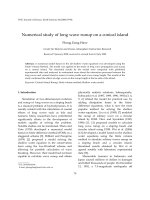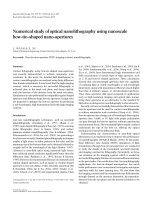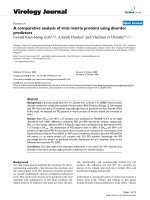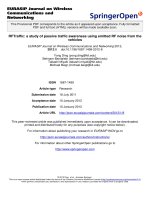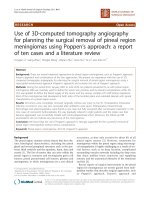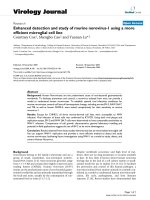Numerical study of metal matrix nanocomposites using discrete dislocation approach
Bạn đang xem bản rút gọn của tài liệu. Xem và tải ngay bản đầy đủ của tài liệu tại đây (7.75 MB, 262 trang )
NUMERICAL STUDY OF
METAL MATRIX NANOCOMPOSITES
USING DISCRETE DISLOCATION APPROACH
ELLIOT LAW
NATIONAL UNIVERSITY OF SINGAPORE
2011
NUMERICAL STUDY OF
METAL MATRIX NANOCOMPOSITES
USING DISCRETE DISLOCATION APPROACH
ELLIOT LAW
(B. Eng. (Civil) (Hons), NUS)
A THESIS SUBMITTED
FOR THE DEGREE OF DOCTOR OF PHILOSOPHY
DEPARTMENT OF CIVIL AND ENVIRONMENTAL ENGINEERING
NATIONAL UNIVERSITY OF SINGAPORE
2011
i
Acknowledgements
First and foremost, praise be to God for His goodness and faithfulness in bringing me
through this entire study. I thank God for blessing me with wisdom and sustaining me
with good health as I worked on this project. I would also like express my deepest
thanks to my parents and family members for their unconditional love and support
throughout all these years.
I would like to express my utmost gratitude to my supervisors, Dr. Pang Sze Dai and
Prof. Quek Ser Tong, for their advice, guidance and counsel since my undergraduate
years. I have learnt so much from them and it has been such a great pleasure and joy
to be able to work with them. I am also very grateful for their care and support; they
have inspired me to do likewise toward others and to give my best in all my
undertakings. I would also like to thank the National University of Singapore (NUS)
for supporting me with the Research Scholarship for the entire duration of my study.
I would also like to acknowledge my fellow students whom I have had the
opportunity to work with throughout the duration of my studies. A special note of
appreciation to Mr. Tran Diep Phuoc Thao, Ms. Liu Lihui, Ms. Matilda Loh and Mr.
Too Jun Lin for their friendship, encouragement and support; the joy of working with
them has made my work more meaningful as well as given me the impetus and
motivation to complete this pursuit.
ii
Last but not least, I would like to express my thanks to the staff at the Structural
Engineering Laboratory, especially Mdm. Annie Tan (who has since transferred to the
Engineering Design and Innovation Centre) and Mr. Ang Beng Oon, for their support
in this project. I would also like to acknowledge Dr. Sharon Nai Mui Ling from the
Singapore Institute of Manufacturing Technology (SIMTech) for her tremendous
assistance in the experimental work conducted for this study. Special thanks also to
Assoc. Prof. Manoj Gupta and Dr. Khin Sandar Tun from the Department of
Mechanical Engineering at NUS as well as Mr. Lam Kim Song from the Fabrication
Support Centre of the same department for their help in the fabrication and machining
of the nanocomposite specimens as well as sharing of experimental results on tensile
properties and microstructural characteristics.
Give thanks to the Lord, for He is good; His love endures forever. (Ps. 107:1)
iii
Table of Contents
Acknowledgements
i
Table of Contents
iii
Summary
viii
List of Tables
xi
List of Figures
xii
List of Symbols
xxii
1.0 Introduction
1
1.1 Metal matrix composites – overview 1
1.2 Numerical studies on metal matrix composites 3
1.2.1 Metal matrix composite systems 3
1.2.2 Influence of various microstructural features on
mechanical properties of metal matrix composites
4
1.2.3 Microstructural modelling using representative
volume element approach
6
1.2.4 Boundary conditions for representative volume
element
8
1.3 Metal matrix nanocomposites – overview 9
1.4 Size effects on mechanical properties of metal matrix
composites
13
1.5 Methods of computer simulations for dislocations 15
1.5.1 Atomistic methods 16
1.5.2 Continuum methods 17
1.5.3 Extended finite element method 19
iv
1.5.4 Multi-scale modelling and coupled atomistic-
continuum methods
20
1.6 Numerical simulations of metal matrix nanocomposites 21
1.7 Objective 25
1.8 Scope and limitations 25
1.9 Organization of the study 26
2.0 Theoretical framework for composite material model using
discrete dislocation method
27
2.1 Dislocations – basic concepts and characteristics 27
2.2 Discrete dislocation formulation 32
2.2.1 Instantaneous state of dislocated body 32
2.2.2 Forces between dislocations 35
2.2.3 Constitutive relations for motion of dislocations 36
2.2.4 Constitutive relations for creation and annihilation of
dislocations
39
2.3 Analytical solutions for dislocation fields in two-dimensional
space
43
2.3.1 Special case of two-dimensional space with horizontal
slip planes
45
2.4 Implementation of discrete dislocation formulation for two-
dimensional unit cell analyses
50
2.5 Computational scheme 54
3.0 Numerical implementation issues
59
3.1 Computational time-step and efficiency 59
3.1.1 Evaluation of boundary nodal forces due to
dislocation stress field
59
v
3.1.2 Effect of cut-off distance on calculation of dislocation
fields
63
3.1.3 Evaluation of dislocation glide force 65
3.1.4 Time-step 67
3.1.5 Tracking of dislocation events and processes 69
3.2 Calibration of material parameters for dislocation processes 72
3.2.1 Density and strength of impurities or obstacles 74
3.2.2 Density of dislocation sources 80
3.2.3 Nucleation strength of dislocation sources 82
3.2.4 Calibration procedure 84
3.3 Size of representative volume element 90
3.3.1 Density of dislocation sources 94
3.3.2 Strength and density of impurities 98
3.3.3 Change in mean overall response with number of
realizations
100
3.3.4 Overall response of composite material 104
4.0 Effects of microstructural features and constituent material
properties on mechanical response of metal matrix
nanocomposites
111
4.1 Inclusion volume fraction 111
4.2 Inclusion size 115
4.3 Inclusion aspect ratio and orientation 118
4.4 Arrangement of inclusions 124
4.5 Material properties of constituent phases 132
4.6 Nature of dislocation pile-ups in metallic nanocomposites 137
vi
5.0 Simulation of damage in metal matrix nanocomposites
141
5.1 Damage of inclusions 144
5.1.1 Effects of fracture strength, volume fraction and size
of inclusions
145
5.1.2 Effect of inclusion arrangement 156
5.2 Matrix damage 160
5.2.1 Effect of void formation in a pure metallic matrix 162
5.2.2 Effect of void formation in a metallic nanocomposite 166
5.2.3 Effect of inclusion volume fraction 170
5.2.4 Effect of inclusion arrangement 174
6.0 Experimental verification
181
6.1 Experimental method 181
6.1.1 Fixture assembly and installation 189
6.1.2 Testing procedure 191
6.2 Materials processing and specimen fabrication 193
6.3 Experimental results 196
6.3.1 Hardness and tensile properties 196
6.3.2 Stress-strain response under shear 196
6.4 Comparison with numerical results 201
7.0 Conclusions and future work
205
7.1 Conclusions 205
7.2 Recommendations for future work 208
7.2.1 Effect of interfacial zone 208
7.2.2 Consideration of crystallographic details 213
vii
References
217
Appendix A: Modifications to standard Iosipescu shear test fixture for
testing of smaller specimens
231
Appendix B: List of publications
235
viii
Summary
A metal matrix composite (MMC) is a composite material with reinforcement phase
which is dispersed within a continuous metallic host to improve the thermo-
mechanical properties of the host metal. Recent experiments show that reducing the
reinforcement size to the nanoscale dramatically increases the mechanical strength of
MMCs. While extensive numerical studies on the mechanical properties of
conventional MMCs have been conducted, only a handful of such studies exist for
metal matrix nanocomposites (MMNCs). Numerical simulations are useful for
performing virtual experiments on MMNCs to explore effects which are currently
difficult to investigate experimentally and to analyse the underlying processes that
govern the mechanical response of these materials. Hence, the objective of this study
is to investigate the mechanical properties of MMNCs using numerical simulations in
order to determine the best combinations of constituent material properties,
compositions and microstructure for optimum mechanical performance of these
materials.
Two-dimensional discrete dislocation analysis implemented using the multi-inclusion
representative volume element (RVE) approach is adopted for the simulations. A
calibration procedure is developed to determine the suitable values for various
parameters which describe dislocation processes in a pure metallic matrix. Suitable
RVE sizes required for the modelling of MMNCs are also established; it is found that
a statistically representative RVE should have approximately 70 to 80 inclusions.
ix
Simulations conducted to investigate the effects of microstructural features on the
overall response of MMNCs show that higher inclusion volume fraction and smaller
inclusion size increase the mechanical strength since impediment to dislocation
motion is enhanced. Inclusion aspect ratio seems to have little influence on the
overall response if the inclusions are randomly aligned, but the flow stress increases
with increasing proportion of inclusions which are aligned perpendicular to the
dislocation slip planes. The simulations also reveal that the flow stress and degree of
hardening are lowest for MMNCs with regular rectangular and highly clustered
inclusion arrangements as there are many unimpeded slip planes, but non-clustered
random and mildly clustered inclusion arrangements result in improved overall
response. Furthermore, the elastic properties of the reinforcement phase seem to have
little effect on the overall response of MMNCs at low inclusion volume fractions, but
their influence is more apparent at large inclusion volume fractions.
The simulations also show that damage of the inclusions and matrix has significant
influence on the mechanical response of MMNCs. Lower inclusion fracture strength
causes lower composite flow stress, earlier onset of inclusion damage and higher
fraction of damaged inclusions. In addition, non-clustered random and mildly
clustered inclusion arrangements lead to more inclusion damage compared to regular
rectangular and highly clustered arrangements because the former result in more
effective impediment to dislocation motion. Also, matrix damage due to void
formation leads to lower overall strength of MMNCs. Void formation is dominated
by rather well-dispersed void nucleation in cases with well-distributed inclusions, but
clustered inclusion arrangements cause void formation around inclusion clusters and
earlier onset of void growth.
x
Finally, experiments are conducted using the V-notched beam method (also known as
the Iosipescu shear test) with a modified test fixture to investigate the effect of
inclusion volume fraction in a magnesium – zinc oxide nanocomposite. The
experimental results display the same trend as predictions from the discrete
dislocation simulations, but the improvement in flow stress shown in the numerical
results is much less significant compared to the experimental results. This is because
the contribution from the interfacial zone between the matrix and inclusions has not
been taken into account in the simulations; the discrepancy between the experimental
and numerical results in the present study indicates the importance of the interfacial
zone in the mechanical properties of MMNCs.
xi
List of Tables
Table 1.1 Mechanical properties of Mg–Al
2
O
3
nanocomposites with
different alumina inclusion sizes.
10
Table 1.2 Mechanical properties of Mg–SiC nanocomposites with
different nano-size inclusion contents (by volume).
10
Table 1.3 Mechanical properties of Al–Al
3
Ti nanocomposites with
different nano-size inclusion contents (by volume).
12
Table 3.1 Boundary nodal forces due to dislocation stress field using
adaptive and Gauss quadratures with different controlling
parameters.
61
Table 3.2 Total computational time required using different error
tolerance values.
62
Table 3.3 Total computational time required using different
maximum number of subdivisions.
62
Table 3.4 Total computational time required (up to γ
ave
= 0.375%)
using different cut-off distances r
cu
t
.
64
Table 3.5 Variation of steady-state flow stress τ
flow,ss
with ρ
obs
(τ
obs
=
0.15 GPa).
78
Table 3.6 Effect of various parameters for dislocation processes on
the overall response of the metallic matrix.
85
Table 3.7 Number of inclusions in RVE for different RVE size,
inclusion size and inclusion volume fraction.
110
Table 6.1 Hardness and tensile properties of Mg-ZnO
nanocomposites with different ZnO inclusion volume
fractions.
197
Table 6.2 Comparison between experimentally-determined and
expected shear moduli of Mg-ZnO nanocomposites with
different ZnO inclusion volume fractions.
200
xii
List of Figures
Figure 1.1 Two-dimensional schematic diagram of a inclusion-
reinforced metal matrix composite.
2
Figure 1.2 Typical tensile stress-strain curves for magnesium
reinforced with nano-size silicon carbide at various
inclusion contents (by weight).
10
Figure 1.3 Tensile properties of aluminum matrix composites. 12
Figure 1.4 Overall shear stress response and distribution of
dislocations in composite material obtained using discrete
dislocation simulations.
23
Figure 2.1 Schematic illustration of types of point defects: self-
interstitial, vacancy, interstitial and substitutional.
28
Figure 2.2 Atom positions and stress field around an edge dislocation. 28
Figure 2.3 Screw dislocation within a crystal. 29
Figure 2.4 Motion of an edge dislocation under an applied shear stress. 30
Figure 2.5 Schematic illustration of slip planes and slip bands in a
single crystal (grain) subjected to a shear stress.
30
Figure 2.6 Slip lines on the surface of a polished and deformed
polycrystalline specimen.
31
Figure 2.7 Problem formulation and decomposition of problem for
dislocated body with inclusions into problem of interacting
dislocations in the homogeneous infinite solid and the
complementary problem for the non-homogeneous body
without dislocations.
33
Figure 2.8 Nucleation of new dislocation pair from a Frank-Read
source in a three-dimensional crystal.
40
Figure 2.9 Generation of a dislocation dipole. 42
Figure 2.10 Sign convention for slip plane and dislocation orientations. 44
Figure 2.11 Contours of dislocation stress field components. 47
Figure 2.12 Creation of an edge dislocation using Volterra’s methods. 48
xiii
Figure 2.13 Distribution of shear stress of a positive edge dislocation
around the centre, in a linear elastic medium and in a
medium having an ideal shear strength.
51
Figure 2.14 Unit cell in a doubly-periodic array subjected to simple
shear.
52
Figure 2.15 Computational procedure within each time step for discrete
dislocation formulation.
58
Figure 3.1 Dislocations near element boundaries. 61
Figure 3.2 Overall response for composite material with different
(a) error tolerance values, and (b) maximum number of
subdivisions for adaptive quadrature used to evaluate
boundary nodal forces due to dislocation stress field.
62
Figure 3.3 Overall response for composite material with different cut-
off distances r
cu
t
used in the evaluation of dislocation fields.
64
Figure 3.4 Distribution of dislocations within matrix of composite
material for cut-off distance r
cut
of (a) 100 b, and
(b) 10000 b.
64
Figure 3.5 Binary tree used to search for element in which a
dislocation is located.
71
Figure 3.6 Overall response of aluminum matrix for different
realizations of random dislocation source and impurity
distributions.
75
Figure 3.7 Mean overall response of metallic matrix for different
values of ρ
obs
with τ
obs
of (a) 0.15 GPa, and (b) 1.20 GPa.
75
Figure 3.8 Deformation of RVE and distribution of dislocations within
metallic matrix with ρ
obs
= 80 μm
-2
and τ
obs
of (a) 0.15 GPa,
and (b) 0.60 GPa.
76
Figure 3.9 Mean overall response of metallic matrix for different
values of τ
obs
with ρ
obs
of (a) 80 μm
-2
, and (b) 160 μm
-2
.
78
Figure 3.10 Distribution of dislocations within metallic matrix with τ
obs
= 0.60 GPa and ρ
obs
of (a) 80 μm
-2
, and (a) 320 μm
-2
.
80
Figure 3.11 Mean overall response of metallic matrix for different
values of ρ
nuc
with τ
obs
of (a) 0.15 GPa, and (b) 1.20 GPa.
81
Figure 3.12 Distribution of dislocations within metallic matrix with τ
obs
= 0.60 GPa and ρ
nuc
of (a) 40 μm
-2
, and (a) 160 μm
-2
.
82
xiv
Figure 3.13 Mean overall response of metallic matrix for different
values of τ*
nuc
with τ
obs
of (a) 0.15 GPa, and (b) 1.20 GPa.
83
Figure 3.14 Overall response of metallic matrix with different
deformation stages indicated.
87
Figure 3.15 Distribution of dislocations within metallic matrix at (a)
initial yield (γ
ave
= 0.05%), (b) Stage 2 (γ
ave
= 0.25%), and
(c) Stage 3 (γ
ave
= 1.5%).
88
Figure 3.16 (a) Adjusting value for τ*
nuc
to match τ
yield
. (b) Increasing
value for ρ
obs
to match Stage 2. (c) Increasing value for τ
obs
to match Stage 3 so that resulting overall response produces
a reasonably good fit with experimental results.
89
Figure 3.17 Mean overall response of metallic matrix for different RVE
sizes with τ
obs
= 0.15 GPa and ρ
nuc
of (a) 160 μm
-2
, and
(b) 40 μm
-2
.
95
Figure 3.18 Deformation of RVE and distribution of dislocations within
metallic matrix for RVE sizes of (a) 0.5 μm × 0.5 μm and
(b) 3 μm × 3 μm with τ
obs
= 0.15 GPa and ρ
nuc
= 160 μm
-2
.
97
Figure 3.19 Mean overall response of metallic matrix for different RVE
sizes with τ
obs
= 0.60 GPa and ρ
nuc
of (a) 40 μm
-2
, and
(b) 160 μm
-2
.
98
Figure 3.20 Mean overall response of metallic matrix for different RVE
sizes with τ
obs
= 0.15 GPa and ρ
obs
of (a) 80 μm
-2
, and
(b) 320 μm
-2
.
99
Figure 3.21 Mean overall response of metallic matrix for different RVE
sizes with τ
obs
= 0.60 GPa and ρ
obs
of (a) 80 μm
-2
, and
(b) 320 μm
-2
.
100
Figure 3.22 Overall response for various realizations of metallic matrix
with ρ
nuc
= 160 μm
-2
, ρ
obs
= 80 μm
-2
and τ
obs
= 0.15 GPa for
RVE sizes of (a) 1 μm × 1 μm, (b) 2 μm × 2 μm, and
(c) 3 μm × 3 μm.
101
Figure 3.23 Mean overall response of metallic matrix computed using
different number of realizations for case with ρ
nuc
= 160
μm
-2
, ρ
obs
= 80 μm
-2
and τ
obs
= 0.15 GPa and RVE sizes of
(a) 1 μm × 1 μm, and (b) 3 μm × 3 μm.
102
Figure 3.24 Overall response for various realizations of metallic matrix
with ρ
nuc
= 40 μm
-2
, ρ
obs
= 320 μm
-2
and τ
obs
= 0.60 GPa for
RVE sizes of (a) 1 μm × 1 μm, and (b) 3 μm × 3 μm.
103
xv
Figure 3.25 Mean overall response of composite material with 50 nm
inclusions for different RVE sizes with inclusion volume
fraction of (a) 2 per cent, and (b) 5 per cent.
105
Figure 3.26 Mean overall response of composite material with 50 nm
inclusions for different inclusion volume fractions and RVE
sizes of (a) 1 μm × 1 μm, and (b) 3 μm × 3 μm.
106
Figure 3.27 Mean overall response of composite material with 100 nm
inclusions for different RVE sizes with inclusion volume
fraction of (a) 2 per cent, and (b) 5 per cent.
107
Figure 3.28 Deformation of RVE and distribution of dislocations within
matrix of composite material with 2 per cent inclusion
volume fraction and 100 nm inclusions for RVE sizes of
(a) 1 μm × 1 μm, and (b) 3 μm × 3 μm.
108
Figure 3.29 Deformation of RVE and distribution of dislocations within
matrix of composite material with 2 per cent inclusion
volume fraction and 50 nm inclusions for RVE sizes of
(a) 1 μm × 1 μm, and (b) 3 μm × 3 μm.
108
Figure 4.1 Mean overall response of composite material with different
inclusion volume fraction and inclusion size of (a) 25 nm,
(b) 50 nm, and (c) 100 nm.
112
Figure 4.2 Distribution of dislocations in composite material with
different inclusion volume fraction and inclusion size.
113
Figure 4.3 Density of dislocations in composite material with different
inclusion volume fraction and inclusion size of (a) 25 nm,
(b) 50 nm, and (c) 100 nm.
114
Figure 4.4 Mean overall response of composite material with different
inclusion size and inclusion volume fraction of (a) 2 per
cent, and (b) 5 per cent.
116
Figure 4.5 Density of dislocations in composite material with different
inclusion size and inclusion volume fraction of (a) 2 per
cent, and (b) 5 per cent.
117
Figure 4.6 Mean overall response of composite material having 2 per
cent inclusion volume fraction and inclusion width of 25
nm with different inclusion aspect ratios.
119
Figure 4.7 Distribution of dislocations in composite material having 2
per cent inclusion volume fraction and inclusion width of
25 nm with different inclusion aspect ratios and alignment.
120
xvi
Figure 4.8 Mean overall response of composite material having
(a) 2 per cent, and (b) 5 per cent inclusion volume fraction
and inclusion volume of 2500 nm
3
/nm with different
inclusion aspect ratios and alignment.
121
Figure 4.9 Distribution of dislocations in composite material having 2
per cent inclusion volume fraction and inclusion volume of
2500 nm
3
/nm with different inclusion aspect ratios and
alignments.
122
Figure 4.10 Distribution of dislocations in composite material having 5
per cent inclusion volume fraction and inclusion volume of
2500 nm
3
/nm with different inclusion aspect ratios and
alignments.
123
Figure 4.11 Mean overall response of composite material with
undamaged inclusions for different regular inclusion
arrangements.
125
Figure 4.12 Distribution of dislocations in composite material with
undamaged inclusions for different regular inclusion
arrangements.
126
Figure 4.13 Mean overall response of composite material with
undamaged inclusions for different irregular inclusion
arrangements.
129
Figure 4.14 Distribution of dislocations in composite material with
undamaged inclusions for different irregular inclusion
arrangements.
130
Figure 4.15 Mean overall response of composite material for inclusions
with different Young’s modulus, inclusion size of 25 nm
and inclusion volume fraction of (a) 2 per cent, and (b) 5
per cent.
133
Figure 4.16 Distribution of dislocations in composite material having 5
per cent inclusion volume fraction and inclusion size of 25
nm.
134
Figure 4.17 Mean overall response of composite material having
inclusion volume fraction of 5 per cent and inclusion size of
100 nm with different values of inclusion Young’s
modulus.
135
Figure 4.18 Mean overall response of composite material for inclusions
with different Poisson’s ratio, inclusion size of 25 nm and
inclusion volume fraction of (a) 2 per cent, and (b) 5 per
cent.
135
xvii
Figure 4.19 Distribution of dislocations in composite material having 5
per cent inclusion volume fraction and inclusion size of 25
nm, with inclusion fracture strength τ
inclusion
= 1000 MPa.
137
Figure 4.20 Illustration of dislocation bowing between inclusions. 140
Figure 5.1 (a) Overall response of composite material with different
values of τ
inclusion
, and (b) corresponding fraction of
damaged inclusions for Realization 1 of random inclusion
distribution with 2 per cent inclusion volume fraction and
inclusion size of 50 nm.
146
Figure 5.2 (a) Overall response of composite material with different
values of τ
inclusion
, and (b) corresponding fraction of
damaged inclusions for Realization 3 of random inclusion
distribution with 2 per cent inclusion volume fraction and
inclusion size of 50 nm.
147
Figure 5.3 Distribution of dislocations in composite material with
Realization 3 of random inclusion distribution, 2 per cent
inclusion volume fraction, inclusion size of 50 nm and
τ
inclusion
= 100 MPa at average shear strain (a) γ
ave
= 0.795%,
and (b) γ
ave
= 0.840%.
148
Figure 5.4 (a) Mean overall response of composite material with
different inclusion fracture strength, and (b) corresponding
fraction of damaged inclusions for random inclusion
distributions with 2 per cent inclusion volume fraction and
inclusion size of 50 nm.
149
Figure 5.5 (a) Overall response of composite material with different
values of τ
inclusion
, and (b) corresponding fraction of
damaged inclusions for Realization 1 of random inclusion
distribution with 5 per cent inclusion volume fraction and
inclusion size of 50 nm.
150
Figure 5.6 (a) Overall response of composite material with different
values of τ
inclusion
, and (b) corresponding fraction of
damaged inclusions for Realization 3 of random inclusion
distribution with 5 per cent inclusion volume fraction and
inclusion size of 50 nm.
151
Figure 5.7 (a) Mean overall response of composite material with
different inclusion fracture strength, and (b) corresponding
fraction of damaged inclusions for random inclusion
distributions with 5 per cent inclusion volume fraction and
inclusion size of 50 nm.
152
xviii
Figure 5.8 (a) Mean overall response of composite material with
different inclusion fracture strength, and (b) corresponding
fraction of damaged inclusions for random inclusion
distributions with 2 per cent inclusion volume fraction and
inclusion size of 100 nm.
153
Figure 5.9 (a) Mean overall response of composite material with
different inclusion fracture strength, and (b) corresponding
fraction of damaged inclusions for random inclusion
distributions with 2 per cent inclusion volume fraction and
inclusion size of 25 nm.
154
Figure 5.10 Mean overall response of composite material with different
inclusion fracture strength for (a) regular rectangular,
(b) highly clustered (NNI = 0.616), and (c) mildly clustered
(NNI = 1.162) inclusion arrangements.
157
Figure 5.11 Distribution of dislocations in composite material with
inclusion fracture strength of 200 MPa for different
inclusion arrangements.
158
Figure 5.12 Average von Mises stress in undamaged inclusions for
composite material with 2 per cent inclusion volume
fraction, inclusion size of 25 nm, and different inclusion
arrangements.
159
Figure 5.13 Fraction of damaged inclusions for different inclusion
arrangements with 2 per cent inclusion volume fraction,
inclusion size of 25 nm, and τ
inclusion
= 200 MPa.
159
Figure 5.14 (a) Mean overall response of pure metallic matrix with
different values of ε
failure
, with the corresponding
(b) percentage of voids, and (c) density of active
dislocations (i.e. excluding annihilated dislocations) in the
matrix.
163
Figure 5.15 Distribution of dislocations in pure metallic matrix with
failure strain ε
failure
of (a) infinity, (b) 0.020 and (c) 0.015 at
γ
ave
= 0.75%; (d) infinity, (e) 0.020 and (f) 0.015 at γ
ave
=
1.5%.
165
Figure 5.16 (a) Mean overall response of composite material with non-
clustered random arrangements of 2 per cent inclusion
volume fraction and inclusion size of 25 nm for different
values of ε
failure
, with the corresponding (b) percentage of
voids, and (c) density of active dislocations (excluding
annihilated dislocations) in the matrix.
167
xix
Figure 5.17 Distribution of dislocations in composite material with non-
clustered random arrangement of 2 per cent inclusion
volume fraction and inclusion size of 25 nm at γ
ave
= 1.05%
for different values of ε
failure
.
168
Figure 5.18 (a) Mean overall response of composite material with non-
clustered random arrangements of 5 per cent inclusion
volume fraction and inclusion size of 25 nm for different
values of ε
failure
, with the corresponding (b) percentage of
voids, and (c) density of active dislocations (excluding
annihilated dislocations) in the matrix.
171
Figure 5.19 Distribution of dislocations in composite material with non-
clustered random arrangement of 5 per cent inclusion
volume fraction and inclusion size of 25 nm at γ
ave
= 1.05%
for different values of ε
failure
.
172
Figure 5.20 (a) Mean overall response of composite material with
regular rectangular arrangements of 2 per cent inclusion
volume fraction and inclusion size of 25 nm for different
values of ε
failure
, with the corresponding (b) percentage of
voids, and (c) density of active dislocations (i.e. excluding
annihilated dislocations) in the matrix.
175
Figure 5.21 Distribution of dislocations in composite material with
regular rectangular arrangement of 2 per cent inclusion
volume fraction and inclusion size of 25 nm at γ
ave
= 1.05%
for different values of ε
failure
.
176
Figure 5.22 (a) Mean overall response of composite material with
highly clustered arrangements of 2 per cent inclusion
volume fraction and inclusion size of 25 nm for different
values of ε
failure
, with the corresponding (b) percentage of
voids, and (c) density of active dislocations (i.e. excluding
annihilated dislocations) in the matrix.
177
Figure 5.23 Distribution of dislocations in composite material with
highly clustered arrangement of 2 per cent inclusion
volume fraction and inclusion size of 25 nm at γ
ave
= 1.05%
for different values of ε
failure
.
178
Figure 6.1 Schematic diagram of specimen used in plane simple shear
tests.
182
Figure 6.2 Shape and standard dimensions for V-notched beam test
coupon (ASTM D 5379).
184
Figure 6.3 Schematic illustration of Iosipescu shear test fixture
(ASTM D 5379).
184
xx
Figure 6.4 Idealized force, shear and moment diagrams for Iosipescu
shear test specimen (ASTM D 5379).
185
Figure 6.5 Picture of Iosipescu shear test fixture used in this study. 186
Figure 6.6 Major components of Iosipescu shear text fixture used in
this study.
187
Figure 6.7 Modifications to Iosipescu shear test fixture for testing of
smaller specimens.
188
Figure 6.8 (a) Small metals pieces used to strengthen grip sections of
specimen. (b) Alignment plate used for alignment of metal
pieces.
188
Figure 6.9 Specimen placement and alignment in the shear test fixture
(ASTM D 5379).
191
Figure 6.10 Locations and alignment of strain gauges on shear test
specimen (ASTM D 5379).
192
Figure 6.11 Schematic diagram of experimental setup used for
microwave sintering.
195
Figure 6.12 Nanocomposite test coupon used in the Iosipescu shear test. 197
Figure 6.13 Stress-strain response under shear for Mg-ZnO
nanocomposite specimens with ZnO inclusion volume
fraction of (a) 0, (b) 0.5, and (c) 1.5 per cent.
198
Figure 6.14 Mean stress-strain response under shear for Mg-ZnO
nanocomposite specimens with different ZnO inclusion
volume fractions.
199
Figure 6.15 (a) Force-time, and (b) strain-time data measured for Mg-
ZnO nanocomposite specimen B2.
199
Figure 6.16 Possible modifications to improve gripping of specimen
within test fixture.
200
Figure 6.17 Comparison between numerically-calibrated and
experimentally-measured overall response of the pure Mg
matrix under shear.
203
Figure 6.18 (a) Numerical, and (b) experimental shear stress - shear
strain response of Mg-ZnO nanocomposite with different
ZnO inclusion volume fraction.
203
xxi
Figure 7.1 Mean overall response of composite material with different
size of interfacial zone as a factor of inclusion size.
212
Figure A.1 Dimensions for additional metal pieces for testing of
smaller specimens.
233
xxii
List of Symbols
B
Bulk modulus
b, b Burgers vector, magnitude of Burgers vector
E
Young’s modulus
f, f Force vector, force component
H
Height of unit cell
K
Stiffness matrix
L
Elastic modulus tensor
L
Distance, length
m
Unit tangent vector of slip plane
N
Element shape function matrix
n
Unit normal vector of slip plane
n
Degree of hardening
p
Polarization stress tensor or vector
S
Surface or boundary
T
Traction tensor or vector
t
Direction vector of dislocation line
t
Time, time duration
U, u, u Displacement tensor or vector, displacement component
V
Volume
v
Outer unit normal vector to a surface
v
Poisson’s ratio
W
Width of unit cell
X, x, Δx Distance or position along x-axis
xxiii
Y, y, Δy Distance or position along y-axis
β
Drag coefficient for dislocation motion
Γ, γ Imposed shear deformation, applied shear strain
ε, ε Strain tensor or vector, strain component
η
Glide velocity of dislocation
θ,
Angle or orientation with respect to x-axis
μ
Shear modulus
ρ
nuc
Density of dislocation sources
ρ
obs
Density of obstacles or impurities
σ, σ Stress tensor or vector, stress component
τ
Shear stress, strength
τ
flow
Flow stress under applied shear deformation
τ*
nuc
Mean nucleation strength of dislocation sources
τ
obs
Strength of obstacles or impurities
